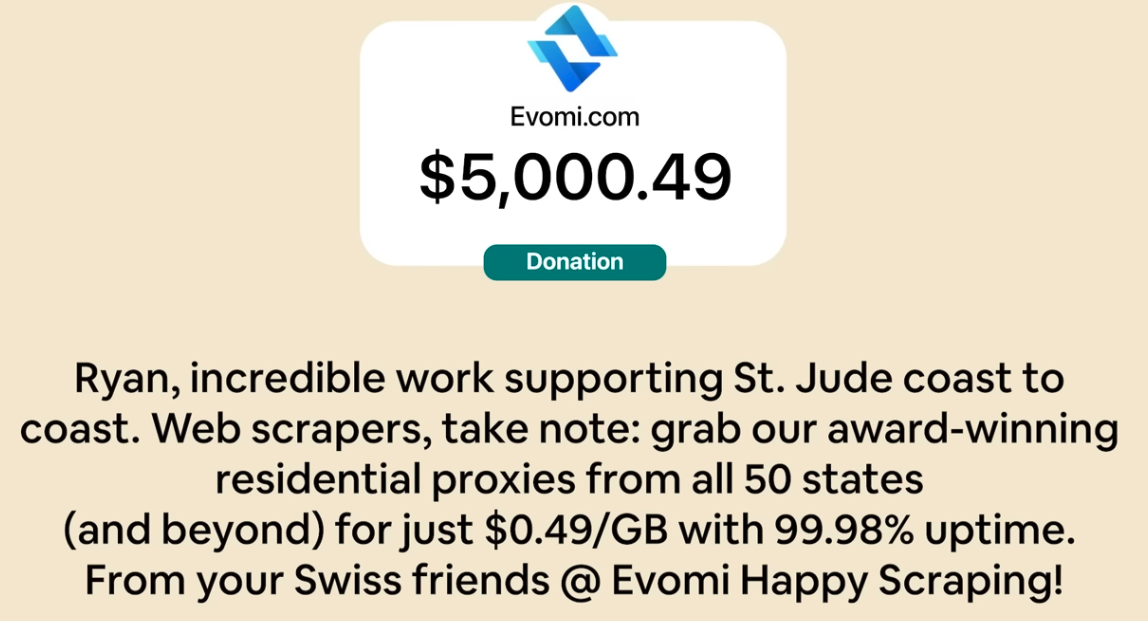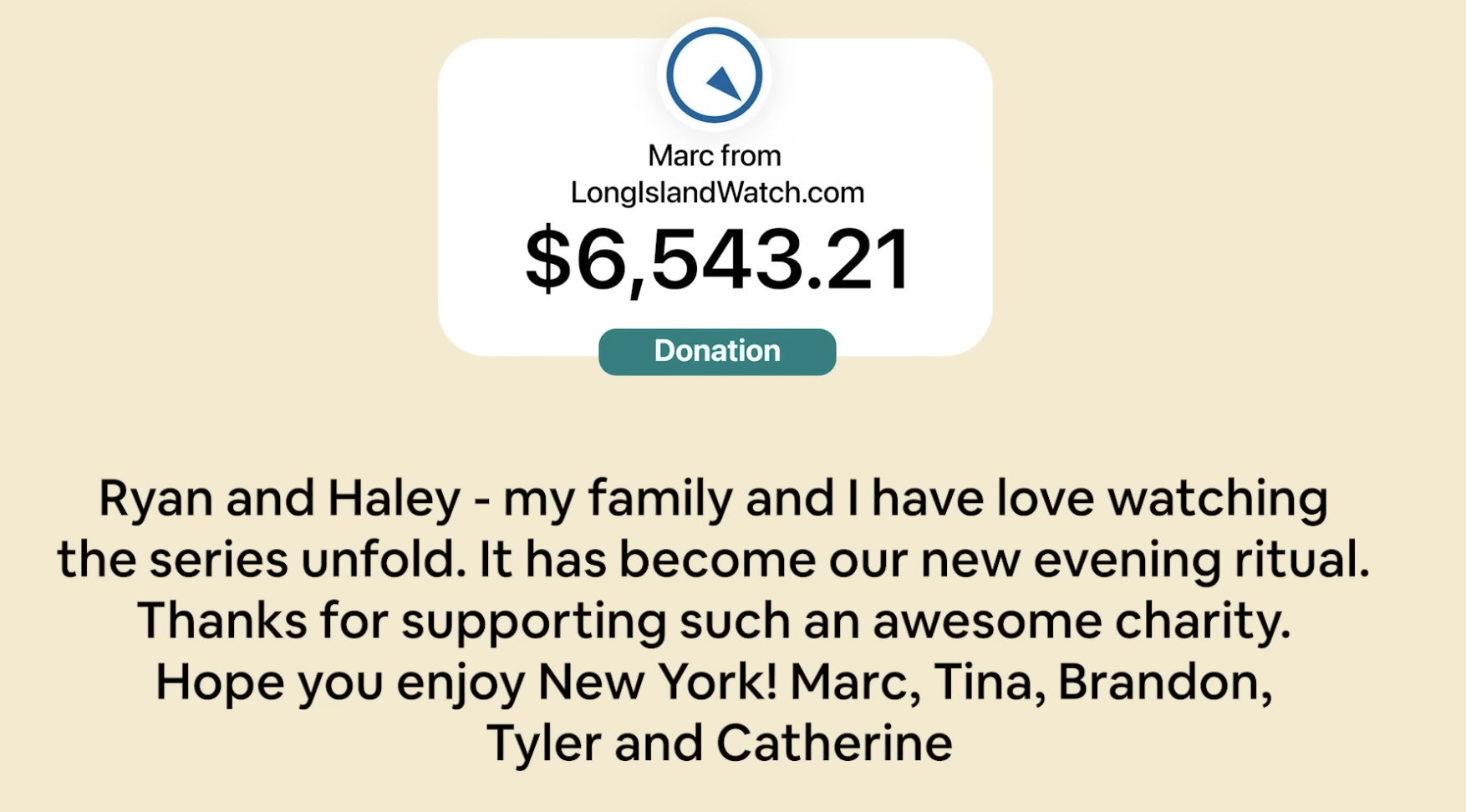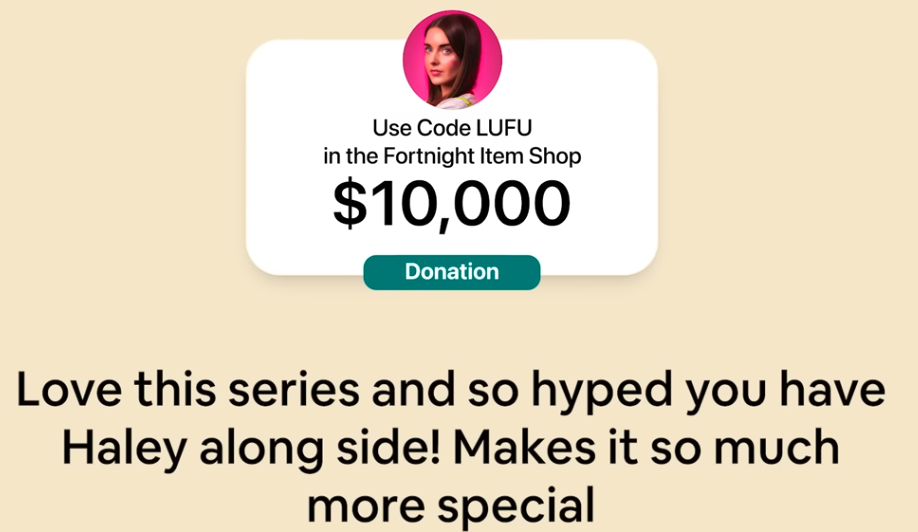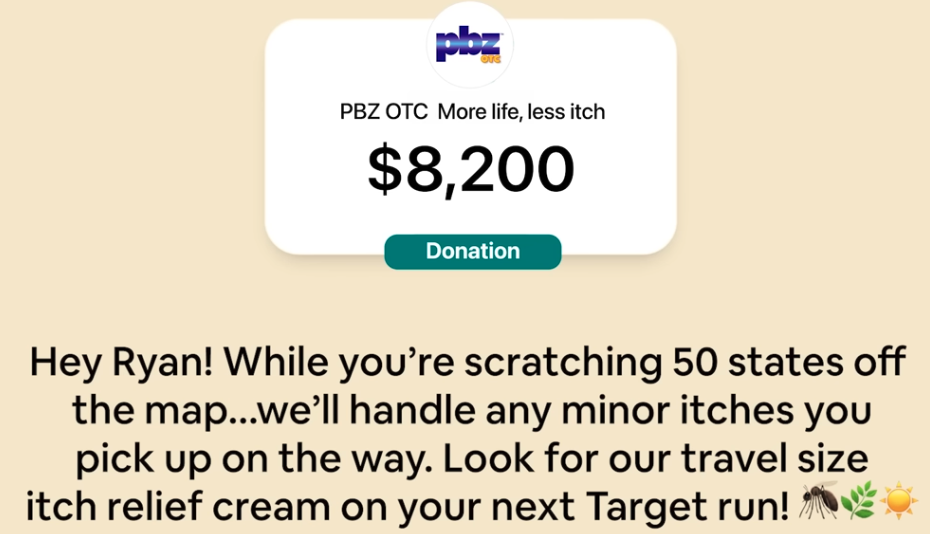Recently, YouTube standout content creator Ryan Trahan created a daily summertime video series, “50 States in 50 Days,” where he and his wife, Haley, set out to sleep over in 50 states in, you guessed it, 50 days. As part of their trip, they chose some of the most unique Airbnbs in each state, awarding a trophy to the most unique house (Spoiler: winner here).
Baked into the series was a $1 million fundraiser for St. Jude Children’s Research Hospital. Donations could be made in any amount, but there were certain thresholds at which greater donor value (and uncertainty for Ryan and Haley) could be unlocked (rundown here).
Donations of $5,000+ resulted in Ryan and Haley giving a verbal shoutout. The donor could post any message they wanted, and it would read aloud, accompanied by an on-screen visual. (Can you say marketing opportunity?)
Donations of $50,000-$99,999 would trigger the Wheel of Doom (WOD). Now, the WOD is a spin wheel, with each slice resulting in a “penalty” that must be accomplished before arriving at the next Airbnb (rules here). It could be something simple, like driving around until the gas tank hits E, or something more menacing, such as requiring the two of them to split up (Yes, this did happen … twice). However, there was one sliver of a wheel that granted a golden ticket, making them immune to the WOD for 24 hours once activated.
Donations over $100,000 allowed the donor to choose the WOD penalty, like Shopify did on day 43.
Following the Series
From day 1, this series became a family staple in my home. We’d try to watch it each night while eating dinner, but with vacations and other travel, we sometimes watched it in the morning or while ironing before a wedding.
From the moment I saw the first video, I blurted out, “Companies should be all over this!”
After all, B2B companies easily spend over $5,000 on paid ads, a webinar, to sponsor a podcast, or have an “influencer” mention their name in a social video. And here, an opportunity for companies to have a YouTuber with 21.3 million subscribers mention their brand name and read their message to people with undivided attention. Seems like a no-brainer opportunity, right?
Well, maybe.
I know what some of you are thinking: isn’t it just kids watching? Well, no. As I mentioned, this was a staple in our home. My 13 and 11-year-olds watched. My professional wife and my professional self watched. We talked about it with our adult friends. And, we discovered new brands in the process.
This is what made the series a genius piece of content. It wasn’t just about the younger audience; it was about the family audience. Need proof? Look no further than the donations read aloud during the series. Time and time again, those who donated mentioned they watched as a family — but how many actually watched?
The very first video had 1.8M views within the first 24 hours. It now has 10 million views. The worst-performing video in the series has 2.2M views. How do those eyeballs compare to a webinar you recently ran, a video with a “business influencer,” or a social media ad?
So, this series was content creation gold, but would it also be as golden a marketing opportunity for brands as it looked?
Let’s look at a couple of examples.
Did Companies Get Value From Donating to 50 States in 50 Days?
1. Lectric eBikes (“Lectric”). Lectric was the first big sponsor, donating $100K, activating the WOD. In the following episode, they delivered an ebike to Ryan and Haley, promising to donate an additional $10K each day he rode the bike during the series. This became a short segment commercial in each video. The bike looked fun, folded nicely, and drove rode me to their website.
In total, Lectric eBikes donated $610K for the series. But was it worth it?
According to Ahrefs (who, BTW, also donated in the series), the brand earned greater than 235M impressions and $7M worth of brand awareness during the series. He-llo!
2. Staple Games. The game developer company initially donated $100K on Day 30, activating the … W.O.D. The company promised to make additional donations based on incentives such as game downloads and in-game achievements. Here is where we begin to get an idea of how well the series could do for a company.
Remember, donors of $100K can choose their WOD penalty. They chose, of course, Silent Treatment, meaning no talking between Ryan and Haley during their trip to the next Airbnb. Nicely, Staple Games suggested Ryan and Haley use the time to play some of their games. This turned into an almost-daily product demo for the company.
They promised to donate $1 for every new game download through the remainder of the series. The next day, they donated $5,347. Then $6,600, $11,000, $16,000, $18,000, and so on. The product demos became longer and more detailed.
In the end, Staple Games became the top donor for the entire 50 States in 50 Days series, donating $815,642!
I wanted to know about their experience and how beneficial this effort was compared to other channels. I reached out to Staple Games, but have not heard back before this article was posted.
However, a user on Linkedin did some “simple math” and calculated that the company received $1.7M of UA value in US installs and $214K of UA value in in-app events (e.g., state unlocks), for a total of $1.9M in UA value on $815K of spend.
For both companies, the ROI seemed positive. But would smaller companies that couldn’t afford a $50K donation see the same benefits?
3. PieCalendar, an event calendar Plugin for WordPress, is a small company that typically spends very little on paid ads. Well, like me, watching was a daily ritual for them, and maybe that allure was too much for them to ignore. On day 27, they opened up their wallet and donated $5K.
So how’d they do?
Unlike Staple Games, they didn’t see the business ROI on their spend. The company told me they did see a spike in traffic (good product awareness), but they did not see as many converted sales during that period.
I had to ask, “Was it worth it?”
“One of our goals is to use our business to do good in the world, so in terms of a $5,000 donation that might help a kid survive childhood cancer, absolutely, it was worth it. We got to be a part of a huge fundraiser and a great project that helped tons of people, so the ROI is secondary to the actual impact the donation had on the cause.”
4. LongIslandWatch.com shared a similar story. The owner, Marc, had been watching the series with his family, and around day five, he realized he wanted to donate. Like PieCalendar, he didn’t do it for purely marketing purposes. On Day 25, Marc’s donation was seen by all.
“I really appreciated what he was doing and wanted to show my support,” Marc said. “If it were an advert, I would have pushed my socials or YouTube video. Though I must admit, the Staple Games thing was GENIUS.”
Knowing the immediate impact on his business wasn’t all that it could be, I asked Marc if he’d do it again.
“I’d do it again, simply from the altruistic aspect,” Marc told me. “I’m planning a donation to another cause that’s 10x the Trahan one, and it likely will see a much smaller audience.”
Was it worth it? How Successful Was 50 States in 50 Days for brands?
This answer depends on expectations. Evomi, a proxy services company, donated in episode 21. Pascal Mueller, Evomi’s Head of Growth, said, “Creator-led, mission-driven campaigns like Ryan’s deliver authenticity you can’t buy with traditional ads. We reached a broad and different audience, supported St. Jude, and built real goodwill—absolutely worth it.”
From an ROI standpoint, the series appeared to be a mixed bag. Companies like Staple Games and Lectric eBikes seemed to do extremely well. In fact, although Staple Games emerged late, they had so much success that they became the top donor in the entire series.
Larger brands such as Shopify, Dollar Shave Club, Starbucks, DoorDash, and T-Mobile, as well as lesser-known brands like MaceyMedia, Visco Software, PieCalendar, LongIslandWatch.com, and RoofMen, joined in the donation fun. Although some saw less ROI from a marketing perspective, those I spoke to were generally okay with that. For them, it was about giving back more than anything.
While the original fundraising goal was $1 million, the 50 States in 50 Days Series raised a total of $11,560,561.
Hats off to all who helped provide patients and families of St. Jude with a little more comfort during difficult times!
This was a great summertime series for families to enjoy. It was a great avenue for brands seeking exposure, and I’m sure others like myself discovered new brands as a result of the series.
I can’t help but wonder: what he heck am I going to watch next, and why I secretly hope it has brand donor ads at the end.
A Few On-Screen Examples of $5,000 Donations:
Here are just a few examples of brands that donated $5K along the way. I am posting for no other reason than for fun. Please reach out if you want your screenshot added.










